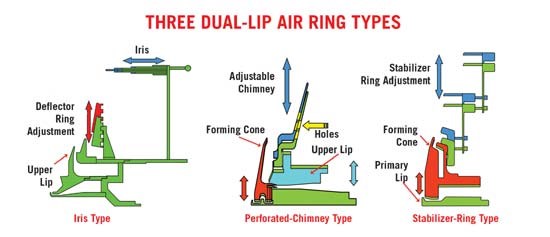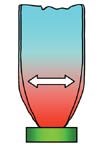What to Do When the Bubble Won't Behave
Bubble instability in blown-film extrusion creates problems from fluctuating film gauge and width to scratches and tears.
Bubble instability in blown-film extrusion creates problems from fluctuating film gauge and width to scratches and tears. Instabilities include draw resonance, helical "snaking," oscillating frost line, and bubble sagging, tearing, fluttering, and "breathing."
The first remedy is adjusting air-ring settings, stabilizing the bubble from the bottom and working your way up. Dual-lip air rings, common for low-melt-strength bubbles, come in three types: iris, perforated-chimney, or stabilizer-ring.
Each requires different corrective actions to be performed in the recommended sequence until the problem stops. The sequence changes according to the specific bubble problem and type of air ring. In some cases, changing resins or modifying equipment may help, though these changes take longer to implement.
Draw resonance
Also known as "hourglassing," this common start-up prob lem occurs when molten film stretches so quickly that it gets stiff. This strain hardening causes internal bubble pressure to increase and decrease at 2- to 10-sec intervals, so film width varies.
The preferred solution is to raise the frost line by increasing extruder output (screw and nip speed) or by reducing bubble cooling. The air ring should be adjusted to reduce the venturi effect and push the bubble away from the deflector ring. The venturi effect is suction caused when high air velocity out of the air ring lowers the pressure between the bubble and air ring. Internal bubble pressure forces the molten film toward the metal surface of the air ring.
To reduce this effect in an iris-type air ring, close the iris or raise the adjustable deflector ring. In a perforated-chimney air ring, open the holes in the chimney. This bleeds off air and reduces cooling. Raising the upper lip and lowering the adjustable chimney also decreases air velocity between the bubble and chimney. Raising the forming cone decreases air velocity from the lower lip, but with most air rings this can't be done while running. With a stabilizer-ring style of air ring, lowering the stabilizer rings lets air leak out, leaving less air to cool the bubble. Lowering the forming cone will also choke air flow from the lower lip, reducing the venturi effect.
In all three air-ring types, decreasing blower speed or closing the damper also decreases air velocity (measured as static pressure inside the air ring) and lowers the volume of air that cools the bubble. Other remedies include increasing melt temperature or changing to a resin with higher melt index that stretches more without strain hardening. Also using a narrower die gap reduces drawdown rate.
Helical instability
Also known as "Mae Westing" or "snaking," this is commonly caused by having a frost line that is too low or a rotating air stream exiting from the air-ring lip, which unlocks the bubble from the deflector, causing 5- to 10-sec undulations. The preferred solution is to raise the frost line by increasing extruder output (screw and nip speed).
If that doesn't fix it, decrease static pressure. With an iris-type air ring, close the iris and/or raise the adjustable deflector ring. With an adjustable-chimney air ring, open the holes in the chimney, raise the upper lip, lower the adjustable chimney, and/or raise the forming cone. With a stabilizer-ring style, lower the forming cone and/or stabilizer rings.
Other remedies include reducing melt temperature or changing to a lower-MI resin with greater melt strength. Using a wider die gap lets a bubble withstand more turbulence inside the air ring.
Frost-line Oscillation
Height oscillation at 30-sec to 5-minute intervals may be caused by surging, drafts, or relatively slow shifts in ambient temperature. Surging will cause extruder motor amps, backpressure, and frost-line height to rise and fall. The simplest solution is to lower the temperature of the extruder feed and second barrel zones. If drafts cannot be eliminated, shield the bubble between the air ring and the frost line. If an IBC is used, check sensor height. For a blow-up ratio over 2:1, sensors should be 2 to 3 in. above the frost line. For a BUR less than 1.5:1, sensors should be at or just below the frost line. The extruder temperature profile should also be adjusted to increase mixing.
Among other remedies, avoid blending resins with very different MIs that don't mix well. Check equipment for problems with air-ring or IBC blowers, uneven haul-off speed, or worn screws that can cause poor mixing or surging.
Bubble sag
A "heavy" or "sleeping" bubble is caused by insufficient cooling. The preferred solution is to lower the frost line. Alternatively, increase static pressure. With an iris-type air ring, close the iris and/or raise the adjustable deflector ring. With an adjustable chimney type, close the holes in the adjustable chimney, lower the upper lip, lower the adjustable chimney, and/or raise the forming cone. With a stabilizer-ring type, lower the rings and/or raise the forming cone.
If there is no other option, decrease extruder output (slower screw and nip speed), decrease melt temperature, or change to a lower-MI resin with greater melt strength. On the equipment side, a narrower die gap lets the bubble cool more quickly.
Bubble tears
Also known as "snap off," this happens when the molten film stretches so far and so fast that it strain hardens and tears off at the die lip. The preferred air-ring adjustment is to reduce the cooling rate. With an iris-type air ring, close the iris and/or raise the adjustable deflector ring, then slow down the blower or close the damper. With an adjustable chimney air ring, open the chimney holes, raise the upper lip, lower the chimney, slow down the blower or close the damper, then raise the forming cone. With a stabilizer-ring type, raise the forming cones, lower the stabilizer rings, then slow the blower or close the damper.
Other adjustments include decreasing extruder output (slower screw and nip speed), increasing die-lip temperature and/or melt temperature, or changing to a higher-MI resin that stretches more without strain hardening. Also a narrower die gap will reduce drawdown rate.
Bubble flutter
This occurs below the frost line and often causes transverse-direction "chatter marks" on the film. The preferred solution is to decrease static pressure. Adjust air velocity by decreasing blower speed or closing the damper. With an iris-type air ring, close the iris and/or raise the adjustable deflector ring. With an adjustable-chimney air ring, open the chimney holes, raise the upper lip, lower the chimney, and/or raise the forming cone. With a stabilizer-ring type, raise the forming cone and/or the stabilizer rings.
Other corrections include decreasing extruder output (slower screw and nip speed), decreasing melt temperature, or changing to a higher-MI resin to reduce average melt temperature. Equipment adjustments include using a narrower die gap so the bubble will cool more quickly.
Bubble breathing
When total air volume inside the bubble changes, it is called breathing. All IBC-cooled bubbles breathe a little. Heavy breathing, however, causes wide fluctuations in layflat width and machine-direction film gauge. Breathing cycles can be short or long. The key issues are the amount of variation, speed of the cycle, and whether it coincides with die or nip rotation.
Air-ring adjustments should focus on stabilizing the bubble inside the air ring. For an iris-type air ring, open the iris and/or lower the adjustable deflector ring, then increase static pressure by increasing blower speed or opening the damper. For an adjustable-chimney air ring, close the holes in the chimney, raise the upper lip, lower the chimney, increase static pressure by increasing blower speed or opening the damper, and then lower the forming cone. With a stabilizer-ring version, lower the forming cone and/or the stabilizer rings, then increase static pressure by increasing blower speed or opening the damper.
Other corrections include reducing melt temperature, going to a higher-MI resin to reduce the average melt temperature of the layers, or decreasing extruder output (slower screw and nip speed). If IBC is used, check valves, blowers, and sensors.
Paul Waller consults on film extrusion and flexible packaging and heads Plastics Touchpoint Group Inc. in Toronto (www.plasticstouchpoint.com), which offers engineering, plant design, machine installation and operator training. He welcomes comments by e-mail: otw@mmsonline.com. Previous articles in this series are found at www.ptonline.com/extrusion.
Related Content
How to Select the Right Cooling Stack for Sheet
First, remember there is no universal cooling-roll stack. And be sure to take into account the specific heat of the polymer you are processing.
Read MoreSingle vs. Twin-Screw Extruders: Why Mixing is Different
There have been many attempts to provide twin-screw-like mixing in singles, but except at very limited outputs none have been adequate. The odds of future success are long due to the inherent differences in the equipment types.
Read MorePart 2 Medical Tubing: Use Simulation to Troubleshoot, Optimize Processing & Dies
Simulation can determine whether a die has regions of low shear rate and shear stress on the metal surface where the polymer would ultimately degrade, and can help processors design dies better suited for their projects.
Read MoreHow Screw Design Can Boost Output of Single-Screw Extruders
Optimizing screw design for a lower discharge temperature has been shown to significantly increase output rate.
Read MoreRead Next
For PLASTICS' CEO Seaholm, NPE to Shine Light on Sustainability Successes
With advocacy, communication and sustainability as three main pillars, Seaholm leads a trade association to NPE that ‘is more active today than we have ever been.’
Read MoreMaking the Circular Economy a Reality
Driven by brand owner demands and new worldwide legislation, the entire supply chain is working toward the shift to circularity, with some evidence the circular economy has already begun.
Read More



























